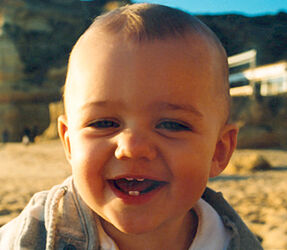07/12/2023
When the first teeth come through, the gums hurt, children chew on things more often, have flushed cheeks, lose saliva and are restless and crying. Teething can also affect appetite and sleep. The temperature can rise slightly. Babies seem to be particularly stressed when the first incisors grow out (lower jaw around the age of 6-10 months, upper jaw around the age of 8-12 months).
“The period of teething also coincides with the phase in which the nest protection is lost, that is, the maternal Antibodies that the child as an unborn child and later possibly through the breastfeeding has noticed lose their effect. High fever of 100°F (38°C) or more, excessive baby discomfort, diarrhea, rashes, mouth blisters, and coughing may indicate an illness unrelated to teething. The pediatrician should clarify this. Herpes infection is also common in children of this age. With the rash on the face and the increased body temperature, it resembles the possible symptoms of teething,” explains Dr. Monika Niehaus, pediatrician and member of the Professional Association of Pediatricians (BVKJ).
Parents can relieve baby teething discomfort by letting baby chew on a chilled teether, wet washcloth, or cool but not icy foods. The cold causes the blood vessels to constrict and reduces inflammation. The pressure on the gums relieves the pain. These foods should only be given to children who are already able to eat solid food. Paediatricians strongly advise against using an amber chain, which some families recommend to relieve pain when teething, because the chains can injure the child while playing or sleeping or even strangle them if they get caught somewhere. “If parents want to use pain-relieving gum gels, they should seek advice from their pediatrician. Some drugs may affect swallowing,” adds Dr. Niehaus.
At four to eight months, the first teeth in the lower jaw break through. All milk teeth have burrowed their way through the gums by about the age of three.
Sources:
- Abdulsatar F, Miller MR, Taheri S. Use of unsafe teething remedies: a survey. J Can Dent Assoc 2022;88:m7.
https://jcda.ca/sites/default/files/m7.pdf - baby teething pain Healthy Children (AAP) 12/20/2018.
https://www.healthychildren.org/English/ages-stages/baby/teething-tooth-care/Pages/Teething-Pain.aspx - Butt RT, Janjua OS, Butt WT, Qureshi SM. All about Teething – Myths to Evidence-Based Treatment. Foundation University Journal of Dentistry. 2022; 2(2):122-132.
https://doi.org/10.33897/fujd.v2i2.302 - Canto FMT, Costa Neto OC, Loureiro JM, Marañón-Vásquez GA, Ferreira DMTP, Maia LC, Pithon MM. Efficacy of treatments used to relieve signs and symptoms associated with teething: a systematic review. Braz Oral Res. 2022 May 2;36:e066.
https://doi.org/10.1590/1807-3107bor-2022.vol36.0066 - Di Pierro F, Bertuccioli A, Donato G, Spada C. Retrospective analysis of the effects of a hyaluronic-based gum gel to counteract signs and symptoms of teething in infants. Minerva Pediatr (Torino). 2022 Apr;74(2):101-106.
https://doi.org/10.23736/S2724-5276.21.06550-2 - Ganobsik K. Teething symptoms and how to help your baby get relief. Health Day, 5/5/2023.
https://consumer.healthday.com/teething-symptoms-2659891265.html - Reeve-Brook L, Bhatia S, Al-Yaseen W, Innes N, Monaghan N. A questionnaire-based study of pediatric dentists’ knowledge of teething signs, symptoms and management. BDJ Open. 2022 Mar 12;8(1):7.
https://doi.org/10.1038/s41405-022-00099-4 - Teoh L, Moses GM. Are teething gels safe or even necessary for our children? A review of the safety, efficacy and use of topical lidocaine teething gels. J Paediatr Child Health. 2020 Apr;56(4):502-505.
https://doi.org/10.1111/jpc.14769
__________________
This is a press release from the Professional Association of Pediatricians (BVKJ). This press release or parts of the article can be printed by citing the following source: www.kinderaerzte-im-netz.de. When publishing in online media, the source must link to this start page or to a subpage of the BVKJ parent portal. In principle, photos and illustrations may not be adopted.

